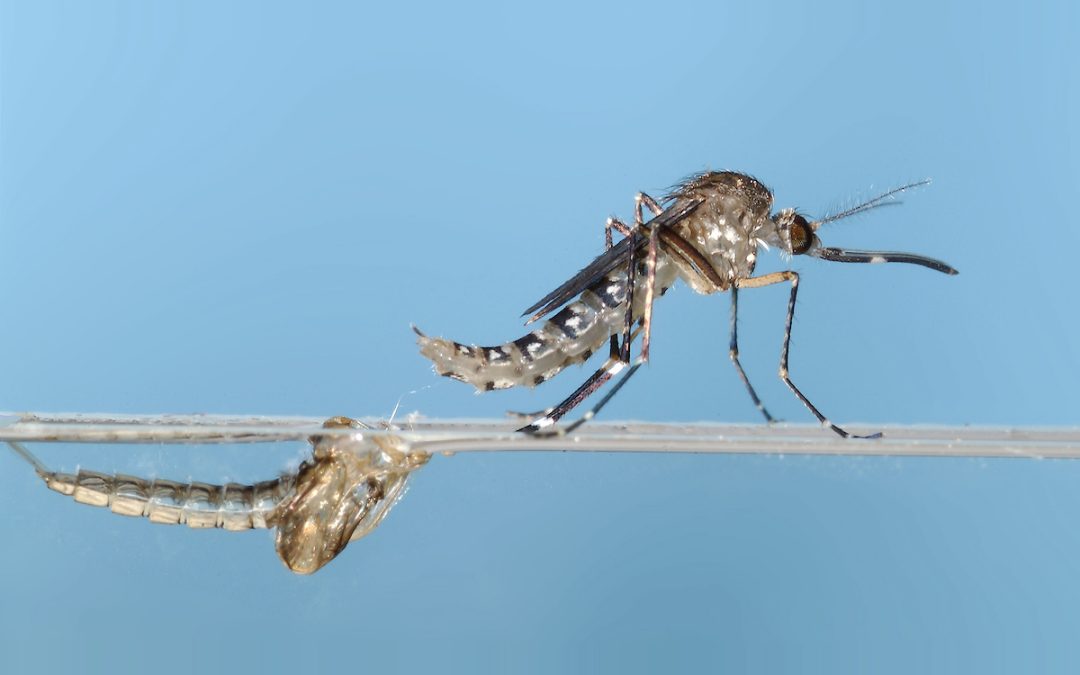
by Julie McConnell | Jun 26, 2025
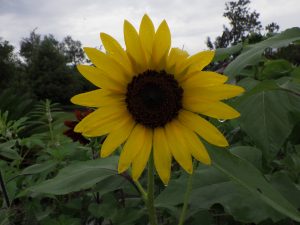
Sunflower after the rain. Photo: J. McConnell, UF/IFAS
Summer showers are finally giving gardens relief, but in addition to happy flowers, mosquitoes are also benefitting from the rainfall. Mosquitoes are not only a nuisance, but they can also transmit diseases and parasites to people, pets, and livestock so managing them on your property is a matter of public health!
The knee-jerk reaction to mosquitoes is to try to kill the blood-sucking flying fiends, but targeting this life stage will not solve the mosquito problem. Instead, focus your efforts on breaking up the breeding cycle to reduce the population. Less ideal breeding sites equals less larvae (juvenile mosquitoes) and pupae which equals less biting adults!
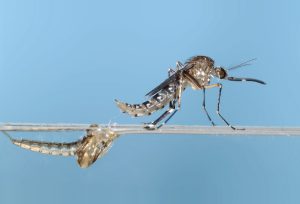
A female black salt marsh mosquito emerges from submerged pupal skin. UF/IFAS File Photo
In addition to being more effective than targeting adults that can fly away or avoid insecticides, most of your breeding site reduction methods are free or low cost; the biggest investment is your time! Step one is to recognize potential breeding sites on your property. Most people recognize that a stack of tires, buckets full of water, or even that decorative bird bath are potential breeding sites but there are also less obvious ones. A covered grill that has an indention that holds a few tablespoons of water, boats or kayaks, children’s toys, gutters that have accumulated leaves or other debris, the saucer under your container plant, or the leaf axils of bromeliad plants are all potential breeding sites.
So, what do you do about this? When practical dump or drain out the water every 3-4 days and wipe down any vertical surfaces of containers where mosquito eggs could be laid. If you are unable to drain or dump, consider treating the water with Bti (Bacillus thuriengiensis israelensis) which is a targeted biological control that only affects mosquitoes, black flies, and fungus gnats. Bti is a naturally occurring bacteria that impacts the digestive system of a few select species in the order Diptera (flies). It is not toxic to people, pets, or wildlife and depending on the formulation can last several weeks before reapplication is necessary. Commonly sold as “mosquito dunks” or “mosquito bits” this insecticide is sold at garden centers and home improvement stores and is relatively inexpensive. As with any pesticide, follow all instructions on the label.
Want to know more about these topics? Visit the references listed below:
Florida Resident Guide to Mosquito Control
CDC Mosquito Control: What you need to know about Bti
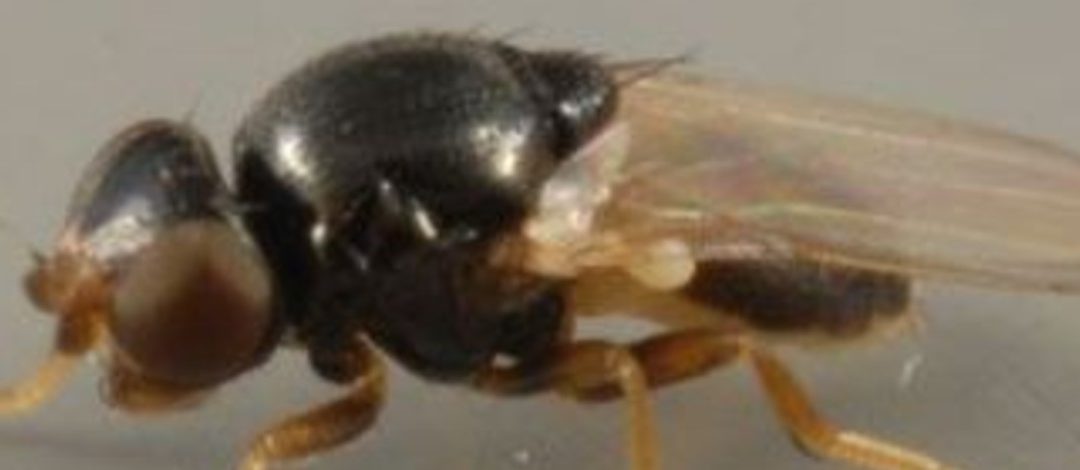
by Larry Williams | Jun 26, 2025
If you’ve been outside this spring, you’ve probably been bothered by gnats. These tiny flies relentlessly congregate near the face getting into the eyes, nose, mouth and ears.
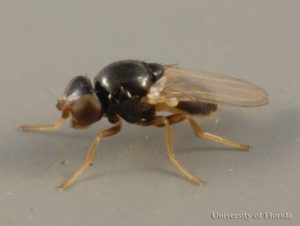
Eye gnat. Credit: Lyle Buss, UF/IFAS
Eye gnats come right up to the faces of people and animals because they feed on fluids secreted by the eyes, nose and ears. Even though eye gnats are considered mostly a nuisance, they have been connected to transmission of diseases such as pink eye.
Eye gnats are true flies. At about one-sixteenth of an inch in length, they are among the smallest fly species in Florida. They are known as eye gnats, eye flies, frit flies and grass flies. The name grass flies is somewhat descriptive as open grass areas such as pastures, hay fields, roadsides and lawns provide breeding sites for these gnats. They also breed in areas of freshly disturbed soil with adequate organic matter such as livestock farms.
Even though these gnats can be found in much of North and South America, they prefer areas with warm, wet weather and sandy soils. Sounds like Florida.
An early spring and plenty of rain are the more likely reasons why these gnats are such a problem in our area this year. Without having the typical last killing frost around mid-March and with early warm weather and rains, the gnats got off to an early start.
Short of constantly swatting them away from your face or just not going outdoors, what can be done about these irritating little flies? I grew up in an area of Georgia where gnats are common. I’ll let you in on a secret, folks who live in Georgia are known to be overly friendly because they are always waving at people who are just passing through. More than likely, these “friendly” folks are busy swatting at gnats, not waving at others who happen to be driving by. Swatting is a quick swinging action with hand as if waving.
Because of their lifecycle, extremely high reproductive numbers in the soil and because insecticides breakdown quickly, area-wide chemical control efforts don’t work well in combating this insect.
The use of the following where gnats are common can be helpful.
- Correct use of insect repellents, particularly those containing DEET
- Screens on windows to prevent the entry of gnats into homes
- Face-hugging sunglasses or other protective eyewear
- Face masks
We may have to put up with these annoying gnats until cold weather arrives and be thankful that they don’t bite.
Additional info on eye gnats is available online at https://edis.ifas.ufl.edu/in884 or from the UF/IFAS Extension Office in your County.
by Lauren Goldsby | Jun 13, 2025
Most gardeners I know love to share plants. Propagating and dividing them can be just as much fun as growing them. Some of my favorite plants in the garden came from loved ones offering a cutting or telling me to dig up whatever I liked.
Lately, I’ve been thinking about how plants can serve as living memories of loved ones who are no longer with us. Many of the plants in my garden are there for that reason- some without me even realizing it. My home garden has become a small collection of plants and memories associated with those plants, and I am the proud keeper of their stories.
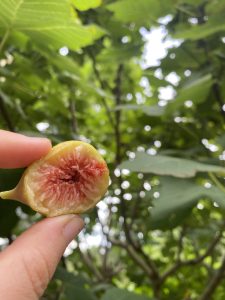
My dad’s fig tree came from a cutting of his grandfather’s fig tree. Newer varieties may yield more and resist disease better, but nothing compares to the fruit you grew up eating with your grandparents on the Fourth of July.
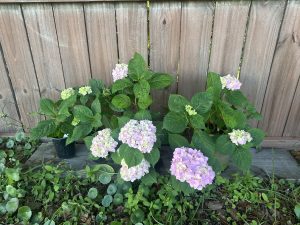
This year, for the first time, I got to enjoy hydrangea blooms from my late grandparents’ home. Before their house was sold, my aunt took last-minute stem cuttings from the bushes. After three years, they’re finally healthy enough to flower- and soon, I’ll take more cuttings to share with the rest of the family.
Sometimes, just being in the garden helps you feel closer to loved ones and the memories you shared. Even if it’s not the same exact plant, growing something they once grew can help you feel connected to them.
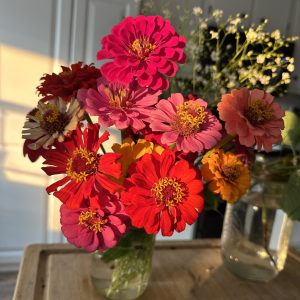
My great-grandmother always said you should have flowers growing in your garden so you can cut them and bring them to people when you visit. When I cut flowers from my garden for friends and family I feel like I am keeping her tradition going.
There are so many plants you can propagate and grow yourself. If you talk to someone who’s been propagating for a while, they’ll likely tell you that it’s as much an art as it is a skill. Try out different plants and methods to see what works best for you. Here’s a great video to get you started with the basics of plant propagation: FFL Plant Propagation Basics.
Are there any plants you grow because of a loved one? It’s never too late to start.
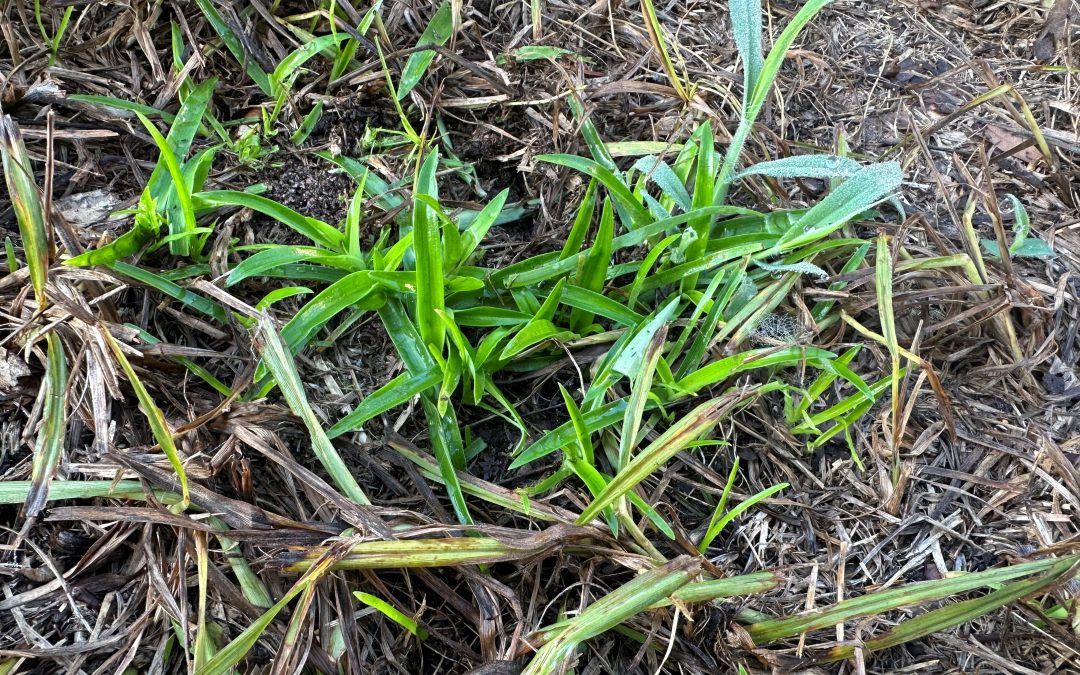
by Daniel J. Leonard | Jun 5, 2025
The Panhandle’s dreaded summer heat has finally arrived in force and has brought with it one of the most difficult to control lawn/landscape weeds, our annual enemy Doveweed (Murdannia nudiflora). Doveweed is characterized as one of the world’s worst weeds due to its broad range of growing conditions, ability to root along its stems, forming mats as it grows, massive seed production (each plant can produce up to 2,000 seeds per year), and inconspicuous nature – it looks like a grass to the untrained eye. So, what can gardeners do to control Doveweed that’s already up this year and prevent it next summer? Let’s find out.
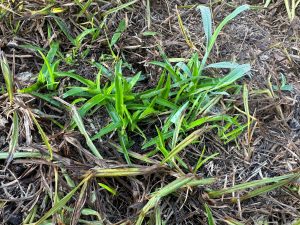
Doveweed emerging in a bare patch of a Centipedegrass lawn in late May 2025. Photo courtesy of Daniel Leonard.
First, the best prevention for all weeds, Doveweed included, is a healthy lawn/landscape. Ensuring healthy, thick Centipedegrass turf and landscaped beds that don’t allow light to hit bare soil goes a long way towards reducing the overall weed load lawns and landscapes can experience. For lawns, this can be achieved through mowing regularly at the proper height for your turfgrass (2.5” or so for Centipedegrass), irrigating no more than 0.75”-1” per week in the absence of rain, limiting stress from overfertilization, and removing excess thatch. In landscapes, preventative weed control focuses on limiting overwatering/fertilization and maintaining a 2-3” organic mulch layer of pinestraw, pine bark, leaves, wood chips, etc. Adopting these practices can greatly reduce the occurrence of weeds in your yard, however they will not eliminate weeds altogether and supplemental chemical weed control is often necessary.
Unlike Crabgrass, Florida Pusley, and other commonly encountered Panhandle annual weeds that emerge when the soil begins to warm in early spring (usually late February-March), Doveweed waits until mid-April-May (soil temperatures of 70-80 degrees F). All these annual weeds are best controlled by preemergent herbicides, like Indaziflam (Specticle G), before seeds germinate. For Doveweed, that means the first preemergent application should occur mid-April with a follow-up application 6-8 weeks later. However, for this year that opportunity is behind us and our only option is post emergent herbicides.
Which postemergent herbicide you choose depends on if your Doveweed issue is in turfgrass or in landscaped beds. In landscaped beds, the primary control option is either hand pulling or spot treating Doveweed with a 41% glyphosate product (Roundup and other generic products) at a rate of 3% (3-4oz glyphosate/gal). As glyphosate is a non-selective herbicide, be sure to not get any overspray on any ornamental plant foliage. In turfgrass, Doveweed control becomes a little more difficult. You essentially have three options – atrazine, a generic 3-way broadleaf product, or a commercial grade broadleaf product. Though it provides very good control of Doveweed and has pre-emergent properties to help discourage future weeds, I don’t prefer atrazine because it has a high potential to leach into groundwater following heavy rains in sandy soils, which describes much of the Panhandle. The generic 3-way products (usually a mix of Dicamba, Mecoprop, and 2,4-D) are fairly effective on Doveweed, however follow-up applications are usually required and the 2-4D component can be harsh on Centipedegrass at the higher label rates required for Doveweed control. Though somewhat expensive, the best post emergent option for most people is probably a commercial grade product like Celsius WG. Celsius WG is a very strong post emergent broadleaf herbicide that is very effective on Doveweed and is also very safe on Centipedegrass, even in hot weather. If the cost of the product (>$100) is off-putting, it is helpful to remember that even at the highest labelled rate, a 10 oz Celsius WG bottle goes a long way, enough to cover several acres of lawn.
* Regardless of what method you choose, be sure to get after emerged Doveweed seedlings early, before they mature and begin flowering – even the strongest post emergent herbicides work better on young weeds.
While Doveweed is a nasty little plant that is perfectly capable of taking over a lawn or landscaped bed, there are a variety of preventative and control options available. Using a combination of the above techniques should help achieve lasting Doveweed controls in future seasons! For more information about Doveweed and other summer annual weed control in lawns and landscapes, contact your local UF/IFAS Extension County office.
by Danielle S. Williams | Jun 5, 2025
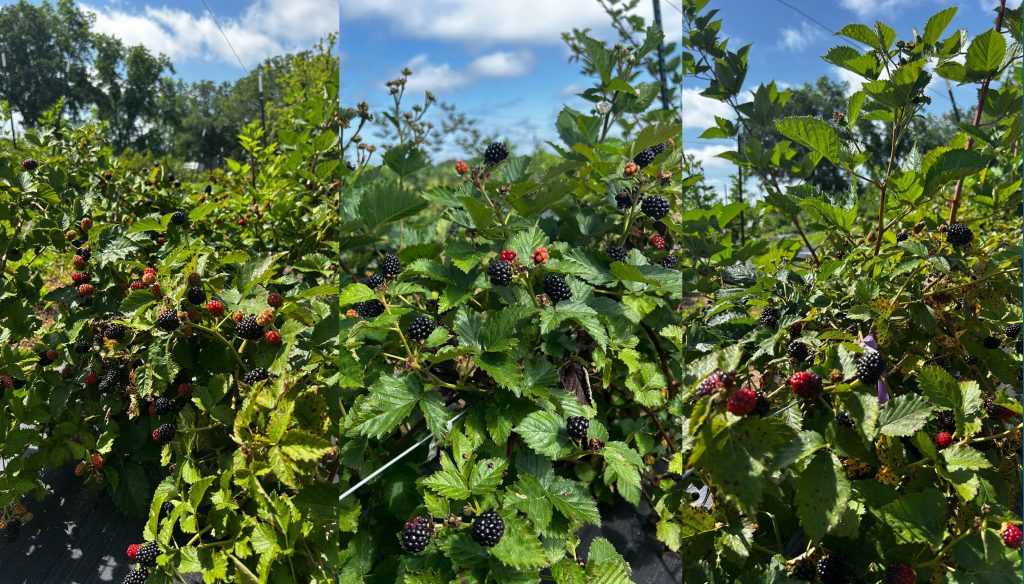
Blackberries grown in North Florida. Photo credit: Dr. Shahid Iqbal
Blackberries are a deciduous crop that thrive in temperate climates. While several native blackberry species grow wild in Florida, their small fruit size, late maturation, and low yields make them unsuitable for commercial production. Historically, cultivated blackberry varieties in Florida, have been primarily limited to homeowner production, but, UF/IFAS researchers are working to change that. Through the development of improved cultivars with higher yields, better flavor, and little to no chilling hour requirements, blackberries are becoming a more viable option for commercial and small-scale growers in North Florida.
UF/IFAS invites you to learn more about blackberries and the current research associated with blackberry production at the Blackberry Field Day, on Wednesday, June 18th. This event will be held from 8:30 – 11:30AM Eastern Time, at the UF/IFAS North Florida Research & Education Center (NFREC), located at 155 Research Road, Quincy, Florida.
This is a free event aimed at educating home gardeners, farmers, landowners, and industry representatives about production practices such as proper planting, pruning, and fertilization. Attendees will be able to tour the blackberry planting at the UF/IFAS NFREC as well as sample different blackberry varieties! The field day aims to present attendees with the potential benefits, challenges, and current research associated with growing blackberries in North Florida.
Attendees will be able to visit the blackberry planting at UF/IFAS North Florida Research & Education Center in Quincy. Light refreshments will be provided. Space is limited, so please register using the link below or by calling 850-875-7255 to reserve your spot!











